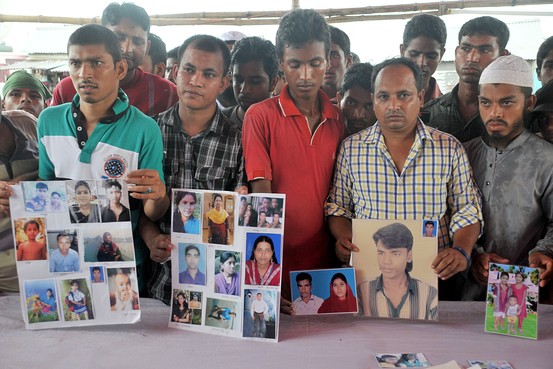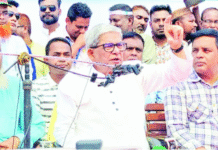When the Bangladeshi passenger ferry MV Pinak-6 foundered and began to sink in the Padma River on Monday, Syed Mohammad Sadi gathered his family together.
“The boat was tilting and waves were crashing through the portholes,” the 37-year-old office worker said. “I grabbed my two sons…and told my wife, Shefali, to hang on to my belt. I knew we would have to swim for it.”
The 50-foot double-decker ferry—packed with people returning to the Bangladeshi capital, Dhaka, from celebrations in the countryside marking the end of the Muslim holy month of Ramadan—capsized within minutes in one of the deadliest ferry accidents in the modern history of Bangladesh.
When Mr. Sadi hit the water, he said, his sons were torn from his grasp. His wife was also pulled away by the current. They are now among 137 people officially listed as missing and presumed drowned. Only two bodies have been recovered, with the rest believed to be trapped in the boat at the bottom of the river, about 25 miles south of Dhaka.
Around 120 people were rescued by local volunteers, but as of Wednesday, the Bangladeshi navy hadn’t been able to locate the sunken craft and the bodies presumed to be inside it.
“The river is about 70 feet deep at this point,” said Capt. Nazrul Islam, the navy officer coordinating rescue operations in Maowa. “We have searched the river bed up to 5 kilometers downstream using sonar. But there is still no sign of the boat.”
Relatives of missing passengers protested Wednesday over what they said was the slow pace of the salvage operation.
Witnesses said the Pinak-6 appeared dangerously overloaded. Survivors said there were about 300 people aboard the vessel, which a Shipping Ministry official who declined to be named said had a registered capacity of 85.
“It should not have been on the water at all,” said the official. “It was carrying three times its listed capacity on the day of the accident.”
Ferry accidents claim scores of lives every year in Bangladesh, especially during the monsoon season, and are typically attributed to overloading, unsafe vessels and poor navigation facilities in a country where boats are the most common mode of travel and regulations are seldom enforced.
Samsuddoha Khondaker, chairman of the Bangladesh Inland Waters Transportation Authority, said his agency, which oversees river travel, lacks the manpower needed to adequately supervise the loading and unloading of thousands of ferries and other boats. He said the Pinak-6 had received a “temporary token” to operate after its license had expired.
“We’re liaising with the police and district officials to stop overloading. But passengers themselves also need to be careful not to get on ferries that are over capacity,” Mr. Khondaker said.
On Tuesday, officials of the authority filed a criminal complaint accusing six people—the Pinak-6’s owner and its skipper, helmsman and three other crew members—of causing death by negligence. None could be reached for comment and it wasn’t clear if they were represented by lawyers.
According to the Shipping Ministry data, more than 2,900 people have died in nearly 400 ferry accidents in Bangladesh since 1994, the earliest year for which numbers are available.
No one has been prosecuted for negligence over ferry accidents in the past 20 years.
“The design and construction of our local ferries are faulty,” said Khabirul Haque Chowdhury, a professor of marine engineering at the Bangladesh University of Engineering and Technology. “Workmen are still using age-old methods which just aren’t adequate. We lack a culture of safety.”
Although inland waterways officials and police officers are supposed to check the number of passengers boarding the ferries, rules are routinely flouted.
On Tuesday, dozens of overcrowded ferries left the Maowa port, which is used by nearly 15,000 passengers a day. Policemen stationed on the dock looked on as passengers climbed onto the roofs of boats.
Nearby, Mr. Sadi, who said he was pulled from the water by a local fisherman, had joined a throng of people lining the river bank waiting for news of loved ones. Staring at the muddy brown water, Mr. Sadi kept repeating: “I couldn’t hold on. I just couldn’t hold on.”
He said he had given up hope of seeing his wife and children alive. “If I could give them a proper burial, it would give me closure,” he said.
Source: Wall Street Journal










